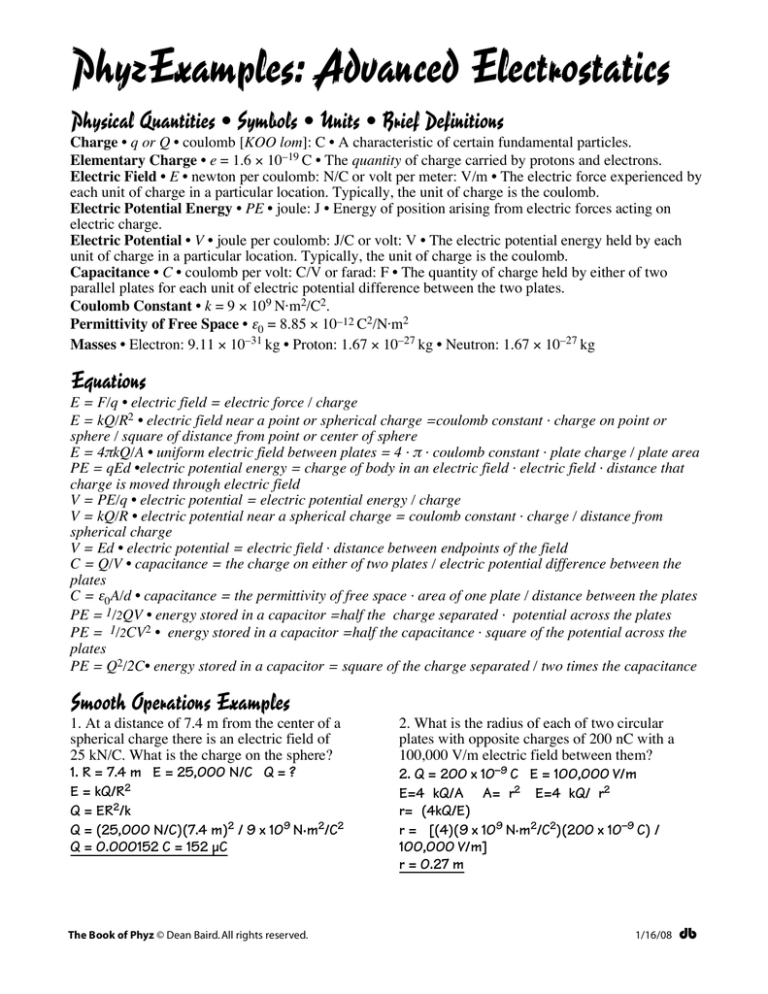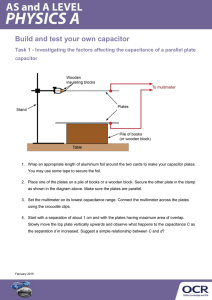
PhyzExamples: Advanced Electrostatics
Physical Quantities • Symbols • Units • Brief Definitions
Charge • q or Q • coulomb [KOO lom]: C • A characteristic of certain fundamental particles.
Elementary Charge • e = 1.6 × 10–19 C • The quantity of charge carried by protons and electrons.
Electric Field • E • newton per coulomb: N/C or volt per meter: V/m • The electric force experienced by
each unit of charge in a particular location. Typically, the unit of charge is the coulomb.
Electric Potential Energy • PE • joule: J • Energy of position arising from electric forces acting on
electric charge.
Electric Potential • V • joule per coulomb: J/C or volt: V • The electric potential energy held by each
unit of charge in a particular location. Typically, the unit of charge is the coulomb.
Capacitance • C • coulomb per volt: C/V or farad: F • The quantity of charge held by either of two
parallel plates for each unit of electric potential difference between the two plates.
Coulomb Constant • k = 9 × 109 N·m2/C2.
Permittivity of Free Space • ε0 = 8.85 × 10–12 C2/N·m2
Masses • Electron: 9.11 × 10–31 kg • Proton: 1.67 × 10–27 kg • Neutron: 1.67 × 10–27 kg
Equations
E = F/q • electric field = electric force / charge
E = kQ/R2 • electric field near a point or spherical charge =coulomb constant · charge on point or
sphere / square of distance from point or center of sphere
E = 4πkQ/A • uniform electric field between plates = 4 · π · coulomb constant · plate charge / plate area
PE = qEd •electric potential energy = charge of body in an electric field · electric field · distance that
charge is moved through electric field
V = PE/q • electric potential = electric potential energy / charge
V = kQ/R • electric potential near a spherical charge = coulomb constant · charge / distance from
spherical charge
V = Ed • electric potential = electric field · distance between endpoints of the field
C = Q/V • capacitance = the charge on either of two plates / electric potential difference between the
plates
C = ε0A/d • capacitance = the permittivity of free space · area of one plate / distance between the plates
PE = 1/2QV • energy stored in a capacitor =half the charge separated · potential across the plates
PE = 1/2CV2 • energy stored in a capacitor =half the capacitance · square of the potential across the
plates
PE = Q2/2C• energy stored in a capacitor = square of the charge separated / two times the capacitance
Smooth Operations Examples
1. At a distance of 7.4 m from the center of a
spherical charge there is an electric field of
25 kN/C. What is the charge on the sphere?
1. R = 7.4 m E = 25,000 N/C Q = ?
E = kQ/R2
Q = ER2/k
Q = (25,000 N/C)(7.4 m)2 / 9 x 109 N·m2/C2
Q = 0.000152 C = 152 µC
The Book of Phyz © Dean Baird. All rights reserved.
2. What is the radius of each of two circular
plates with opposite charges of 200 nC with a
100,000 V/m electric field between them?
2. Q = 200 x 10–9 C E = 100,000 V/m
E=4 kQ/A A= r2 E=4 kQ/ r2
r= (4kQ/E)
r = [(4)(9 x 109 N·m2/C2)(200 x 10–9 C) /
100,000 V/m]
r = 0.27 m
1/16/08
db
3. What is the strength of a uniform electric field
in which 1.3 J of energy are required to move an
object with 8.6 mC of charge a distance of
34 mm?
3. PE = W = 1.3 J q = 8.6 x 10–3 C
d = 0.034 m
PE=qEd
E=PE/qd
E = 1.3 J / 8.6x10–3 C · 0.034 m
E = 4400 J/C·m = 4400 N/C
4. What is the electric potential at a point in
space in which an object with a 2.5 µC charge
has 4.7 J of potential energy?
5. How far from the center of a spherical charge
of 1.0 C would the electric potential be 9.0 V?
6. Two parallel charged plates have a potential
of 7500 V and a uniform electric field of
125,000 V/m between them. How far are the
plates from each other?
5. Q = 1.0 C V = 9.0 V R = ?
V = kQ/R
R = kQ/V
R = 9 x 109 N·m2/C2 · 1.0 C / 9.0 V
R = 1.0 x 109 m ( > 620,000 mi)
7. What is the capacitance of two parallel plates
if each holds a charge of 12 mC when there is an
electric potential difference of 3.0 V between
them?
7. Q = 12 x 10–3 C V = 3.0 V C = ?
C = Q/V
C = 12 x 10–3 C / 3.0 V
C = 4.0 x 10–3 C/V = 4.0 mF
4. q = 2.5 x 10–6 C PE = 4.7 J V = ?
V = PE/q
V = 4.7 J / 2.5 x 10–6 C
V = 1,900,00 V = 1.9 MV
6. V = 7500 V E = 125,000 V/m
V = Ed
d = V/E
d = 7500 V / 125,000 V/m
d = 0.06 m = 6 cm
8. How much charge can be held on each plate
of a 25µF capacitor charged to 120V?
8. C=25x10–6C V=120V Q=?
C = Q/V
Q = CV
Q = 25x10–6 F · 120 V
Q = 0.003 FV = 3.0 mC
9. What is the separation between two parallel
plates if they each have an area of 0.47 m2 and
have a capacitance of 7300 pF?
10. How much energy is stored in a capacitor if
it holds 3.6 C of charge separated at a potential
of 1.4 V?
9. A = 0.47 m2 C = 7300 x 10–12 F d = ?
C = ε0A/d
d = ε0A/C
d = 8.85x10–12C2/N·m2 · 0.47m2 / 7300x10–12F
d = 0.00057m = 0.57mm
10. Q = 3.6 C V = 1.4 V PE = ?
PE = QV/2
PE = 3.6 C · 1.4 V / 2
PE = 2.5 J
11. What is the capacitance of a capacitor that
stores 70 mJ of energy when charged with a
6.0 V battery?
12. How much charge is separated in a 1200 µF
capacitor if it stores 6.4 J of energy?
10–3
11. PE = 70 x
V = 6.0 V C = ?
2
PE = CV /2
C = 2PE/V2
C = 2(70 x 10–3 J) / (6.0 V)2
C = 0.0039 F = 3900 µF
The Book of Phyz © Dean Baird. All rights reserved.
12. C = 1200 x 10–6 F 6.4 J
PE = Q2/2C
Q = (2C·PE)
Q = (2 · 1200 x 10–6 F · 6.4 J)
Q = 0.12 C
1/16/08
db
Nasty Welcome to the Real World Example
9. A particle of mass m and positive charge q is accelerated through a uniform field E created by parallel
plates a distance x apart. The particle passes through a hole in the negatively charged plate. Later, it
enters a vertical field created by two oppositely charged plates separated by a distance 2y and charged to
a potential difference of V as shown in the diagram.
+
–
–
m, q
V 2y
E
x
+
a. Indicate the directions of the horizontal and vertical electric fields and sketch the path of the particle.
b. To what speed is the particle accelerated in the horizontal field?
KEgained = PElost
1/2mv2
= qEx
v = (2qEx/m)
c. What will be the magnitude of the vertical acceleration of the particle in the vertical field?
F= ma
a = F/m F = qE E = V/d = V/2y
a = qV/2ym
d. How far will the particle travel in the vertical field before striking a plate?
2D kinematics
x=d=?
y=y
find t
find d
2
vx = (2qEx / m)
v y0 = 0
y = v y0t + 1/2at
d = vxt
2
v y=?
y = 1/2at
d = (2qEx/m)· (4y2m/qV)
a = qV/2ym
t = (2y/a)
d = 2y (2Ex/V)
t=?
t = (2y·2ym/qV)
t = (4y2m/qV)
The Book of Phyz © Dean Baird. All rights reserved.
1/16/08
db



